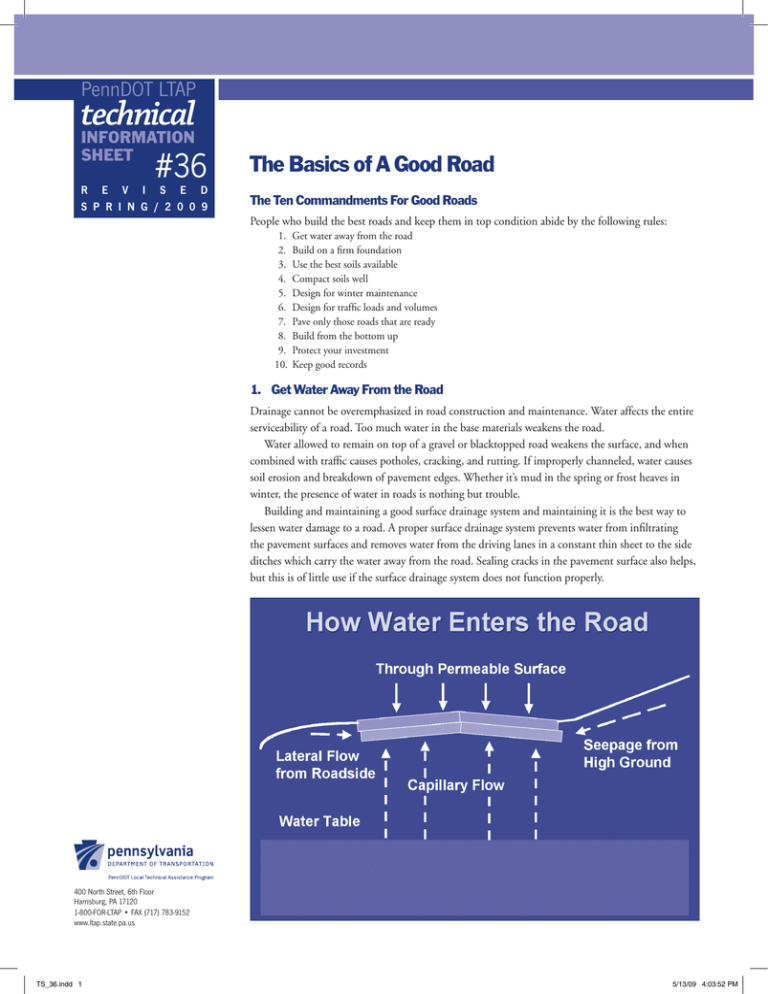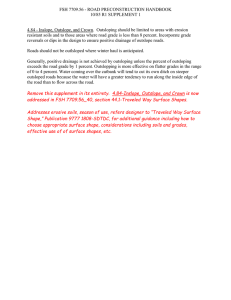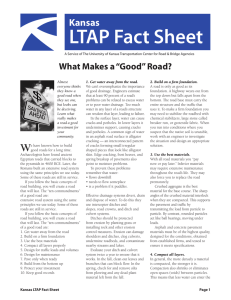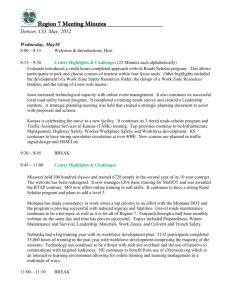(ts36) the basics of a good road
advertisement

PennDOT LTAP technical INFORMATION SHEET #36 R e v i s e d S P R I N G / 2 0 0 9 The Basics of A Good Road The Ten Commandments For Good Roads People who build the best roads and keep them in top condition abide by the following rules: 1. Get water away from the road 2. Build on a firm foundation 3. Use the best soils available 4. Compact soils well 5. Design for winter maintenance 6. Design for traffic loads and volumes 7. Pave only those roads that are ready 8. Build from the bottom up 9. Protect your investment 10. Keep good records 1. Get Water Away From the Road Drainage cannot be overemphasized in road construction and maintenance. Water affects the entire serviceability of a road. Too much water in the base materials weakens the road. Water allowed to remain on top of a gravel or blacktopped road weakens the surface, and when combined with traffic causes potholes, cracking, and rutting. If improperly channeled, water causes soil erosion and breakdown of pavement edges. Whether it’s mud in the spring or frost heaves in winter, the presence of water in roads is nothing but trouble. Building and maintaining a good surface drainage system and maintaining it is the best way to lessen water damage to a road. A proper surface drainage system prevents water from infiltrating the pavement surfaces and removes water from the driving lanes in a constant thin sheet to the side ditches which carry the water away from the road. Sealing cracks in the pavement surface also helps, but this is of little use if the surface drainage system does not function properly. 400 North Street, 6th Floor Harrisburg, PA 17120 1-800-FOR-LTAP • Fax (717) 783-9152 www.ltap.state.pa.us TS_36.indd 1 5/13/09 4:03:52 PM A surface drainage system has four components: road crown, shoulders, ditches, and culverts. The crown or superelevation of the road surface allows water to run-off to the side ditches. Shoulders are an extension of the road surface and allow for the continued flow of water to the ditches. Ditches are used to carry water away from the road. They need to be kept clean and protected from erosion. Water left in the ditch can sometimes leak back into the pavement foundation materials. Water collected and carried in the ditch has to be directed away from the roadway at frequent intervals sometimes using culvert pipe. Culverts usually channel water from one side of the road to the other, helping to control the flow of water and slowing it down to reduce erosion. Roadmasters are guided by the principles that: in the beginning using quality materials, a municipality can correct the weak spots in the roads over a period of years and be assured of a sound base upon which can eventually be applied a permanent hard surface. Using inferior base materials may require excessive maintenance during the road’s life and perhaps costly rehabilitation before paving. The adage “pay now or pay later” applies to road building. Written guidelines exist to help roadmasters classify the usefulness of soil types for road foundations and bases. The guidelines give information on potential frost action, compressibility, and drainage characteristics. 4. Compact Soils Well The more dense the materials, the stronger the base. When soil is improperly compacted, future traffic loads or changes in moisture content can cause settlement and failure of the roadway. Compaction is achieved by pressing soil particles together using rollers, tampers, or vibrators. The air is expelled from the mass, filling the spaces between the particles, and making the material more dense. Well graded soils with a fairly even distribution of particle sizes will compact more easily than poorly graded soils with mainly one particle size. Jagged or semi-jagged will compact to a more stable configuration than rounded particles of similar size. A certain amount of moisture is necessary for good soil compaction. • water runs down hill • water needs outlets at the bottom of all grades • puddles mean problems If it were not for water, a roadmaster’s job would be easy. But because of water, whether in liquid form or as snow or ice, a roadmaster’s work is never done. Except for some moisture that is needed for soil compaction and for dust control, water is the roadmaster’s enemy. 2. Build On a Firm Foundation 5. Design for Winter Maintenance A road wears out from the top but it falls apart from the bottom. This is another way of saying that the road base determines the service life of a road. The base supports everything above it including traffic. If adequate support does not exist, the road will rapidly deteriorate. A good road requires a suitable foundation which in turn requires stable material. A road material is stable if it has little or no change in its volume and does not deform under repeated loads whether the material is wet or dry. Soils can be stabilized using such agents as asphalt, calcium chloride, cements, lime, salt, and other products. To select the proper stabilizing agent, an understanding is required of both the soil and agent to be used. The additive must be of the correct type and in the correct quantity to produce satisfactory results. If a municipality designs its roads for winter maintenance, they would be adequate for the remainder of the year. Consider the following: A one-way plow cuts a nine-foot-wide swath. If the road is wide enough to allow the plow and a school bus to meet, it is wide enough during the remaining seasons of the year. If ditches and roadside areas are wide enough to store snow, they also should accommodate spring thaws and heavy water flows. A municipality will not be sorry for building a wide road, but it may regret building a narrow one. Grades should be a minimum of one percent (1%) for drainage purposes, but should not be greater than ten percent (10%) if at all possible. If the road is steeper than that, it is difficult for heavy equipment to maneuver, especially in wintertime. Sight distance should be considered in designing a road. For safety’s sake, a driver should be able to see 75 to 100 feet up the road for every 10 miles of speed. This rule of thumb may be helpful when issuing permits for driveways onto a local road. 3. Use the Best Soil Available The quality of soils used by a municipality will often depend on local availability and budget. In deciding what is affordable, municipalities should consider the long-term consequences of using lower quality material. By putting down a good base 2 TS_36.indd 2 5/13/09 4:03:52 PM 6. Build for Traffic Loads and Traffic Volumes pavement. It may be necessary in some cases to dig out the old road, put in new material, and build up the road in layers. Before doing anything to correct a road surface problem, roadmasters must take into consideration what is causing the problem underneath. Improper drainage, insufficient depth of base, or poor quality gravel may be the culprits. These should be corrected before spending money on the surface. Ice on a pond will support a young skater, but it will crack under the weight of an automobile or even break apart. Similarly, a road built to serve residential traffic will break down when it starts carrying a number of large trucks. A road test in Illinois established that it takes the passage of approximately 9,600 cars to equal the effect of the passage of one 80,000 pound truck on a road. Roadmasters know that roads, like bridges, should be designed to accommodate the expected traffic type and volume. A rule of thumb is to design a road to accommodate the largest vehicle, which will use the road under normal operations. Designing the road for the largest piece of municipal equipment, which maintains it in all kinds of weather, may suffice. To determine the required depth of base, a common guide is to use three-fourths to one inch (3/4-1”) of gravel for every foot of traveled way width. For example, a 20-foot-wide road should have a 15-to 20-inch (15-20”) gravel base. When considering the type and thickness of pavement mixes to apply on a gravel road, a municipality is wise to seek some advice. Generally speaking, a low-volume road (300 vehicles per day) with some truck traffic may provide good service with a “chip seal.” The main function of such a seal is to eliminate the need to replace and reshape gravel, eliminate dust, and prevent raveling of soils. As traffic volumes and weights increase, the type and thickness of pavement should increase to a point where the pavement itself actually shares the load stress. Heavy-duty interstate highways, for example, have a foot or more of asphaltic concrete below the riding surface. 9. Protect Your Investment Roads and bridges need regular maintenance to keep them from deteriorating. The increased weight and frequency of traffic on roads combined with adverse weather conditions, means an increased rate of road and street deterioration. Regular road and bridge maintenance preserves a road investment and prevents costly major rehabilitation later. Maintenance activities include: • Roadway Surfaces: blading and shaping; patching and resurfacing; dust control; snow and ice removal. • Drainage: cleaning and repairing culverts and ditches. • Roadside: cutting brush, trees, and grass; repair and prevention of roadside erosion. • Bridges: channel clearing; repair of rails, decks, and structure; cleaning and painting. • Traffic Services: sign maintenance. • Special Projects: restoration or improvements; emergency work, such as removing slides and repairing retaining walls. 10. Keep Good Records Roadmasters know their roads like the backs of their hands. Most of them are walking history books when it comes to the roads they manage. This knowledge is of little use, however, when the roadmaster is ill or retires. Good record keeping makes roadwork much easier for everyone. It is better to educate the taxpayers about planned roadwork and the estimated cost before the work is done. Keep records of what type of work is done on a road or bridge, when, and what materials were used. These records can help when making future decisions. Municipalities can start by inventorying all roads and bridges, listing length, width, surface types, culverts, problem areas, etc. Putting these items on a map helps. Next list and assign priorities to needed improvements, estimate the cost of each, and complete a few of these improvements every year. Good record keeping of road/bridge work and equipment is good business. 7. Pave Only Those Roads That Are Ready In their haste to put a smooth surface on a gravel road, some municipalities make the mistake of paving over a road that is not properly prepared. The result may be a complete waste of money. Unless the road base is first built with the proper thickness for the traffic it must bear and the gravel is compacted to a proper density with the ability to drain well, any pavement applied will fail. Experienced roadmasters make sure that a gravel road works well before paving. The cost of reconstructing a failed road is much higher than doing it right the first time. 8. Build From the Bottom Up A road that has a poor base and poor drainage cannot be adequately improved with a top dressing of gravel or new If you have any questions, you can call LTAP at 1-800-FOR-LTAP for assistance. 3 TS_36.indd 3 5/13/09 4:03:52 PM 032305-1011 4/11/05 3:39 PM Page 46




